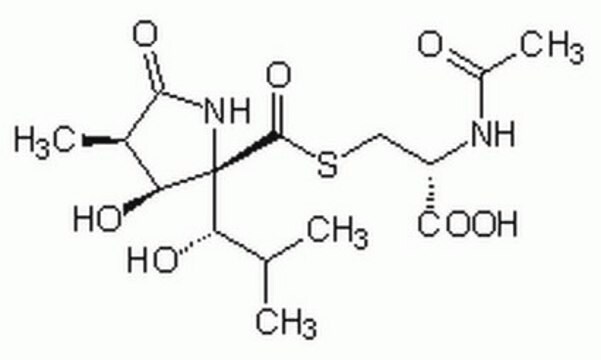539165
Proteasome Inhibitor Set II
The Proteasome Inhibitor Set II controls the biological activity of Proteasome. This small molecule/inhibitor is primarily used for Protease Inhibitors applications.
Iniciar sesiónpara Ver la Fijación de precios por contrato y de la organización
About This Item
Código UNSPSC:
12352200
NACRES:
NA.77
Productos recomendados
Nivel de calidad
formulario
solid
fabricante / nombre comercial
Calbiochem®
condiciones de almacenamiento
OK to freeze
protect from light
Condiciones de envío
ambient
temp. de almacenamiento
−20°C
Descripción general
Contains 5 mg of ALLN (Cat. No. 208719), 100 μg each of Epoxomicin (Cat. No. 324800), and clasto-Lactacystin β-Lactone (Cat. No. 426102). Supplied with a data sheet.
Proteasomes are large multi-subunit protease complexes, which selectively degrade intracellular proteins. A protein marked for degradation is attached to multiple molecules of ubiquitin, a 76-amino acid protein, which escorts it for rapid hydrolysis, by the 26S proteasome. The proteolytic core of this complex consists of the 20S proteasome, which contains multiple peptidase activities and has a molecular mass of ~700 kDa. Recently several potent, cell-permeable proteasome inhibitors have been developed.
The Calbiochem brand offers a set that includes 3 proteasome inhibitors with varying inhibtory effects.
The table below outlines some of the physical and biological properties of these compounds.
The Calbiochem brand offers a set that includes 3 proteasome inhibitors with varying inhibtory effects.
The table below outlines some of the physical and biological properties of these compounds.
Acciones bioquímicas o fisiológicas
Primary Target
calpain 1, calpain 2
calpain 1, calpain 2
Secondary Target
cathepsin B, cathepsin L
cathepsin B, cathepsin L
Envase
Packaged under inert gas
Advertencia
Toxicity: Standard Handling (A)
Información legal
CALBIOCHEM is a registered trademark of Merck KGaA, Darmstadt, Germany
Código de clase de almacenamiento
11 - Combustible Solids
Certificados de análisis (COA)
Busque Certificados de análisis (COA) introduciendo el número de lote del producto. Los números de lote se encuentran en la etiqueta del producto después de las palabras «Lot» o «Batch»
¿Ya tiene este producto?
Encuentre la documentación para los productos que ha comprado recientemente en la Biblioteca de documentos.
Los clientes también vieron
Nuestro equipo de científicos tiene experiencia en todas las áreas de investigación: Ciencias de la vida, Ciencia de los materiales, Síntesis química, Cromatografía, Analítica y muchas otras.
Póngase en contacto con el Servicio técnico
